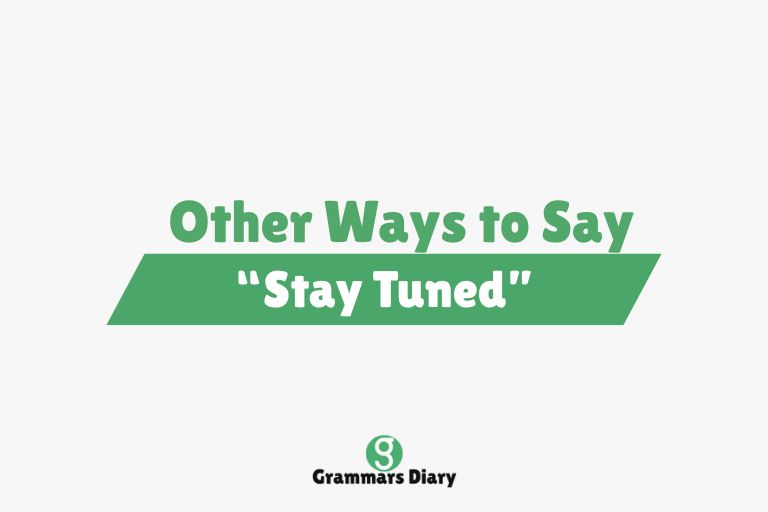The phrase “stay tuned” is widely used in both casual and professional settings to encourage someone to keep paying attention for future updates, announcements, or developments. Whether it’s at the end of a podcast, a YouTube video, or a company newsletter, this phrase carries the promise of more information coming soon.
But while “stay tuned” gets the job done, there are many other expressions that add flair, variety, or professionalism depending on the situation. This article explores 20 creative alternatives to “stay tuned,” giving you fresh ways to maintain engagement, build anticipation, or encourage your audience to remain connected. Whether you’re writing social media posts, crafting business communications, or simply chatting with friends, these alternatives can help you express yourself with more personality and precision.
Other Ways to Say “Stay Tuned”
1. Keep an Eye Out
Example: “Keep an eye out for our upcoming product launch next week.”
Meaning: Be alert and watch for something coming soon.
Usage: Best suited for promotional content or informal announcements where you want your audience to be observant and aware of what’s coming.
2. Watch This Space
Example: “Watch this space for updates on our next big event.”
Meaning: Indicates that more information will be shared soon in the same place.
Usage: Commonly used on websites, social platforms, or emails to imply continuity or developments.
3. More to Come
Example: “We’ve only just begun—there’s more to come.”
Meaning: Suggests that the current message is just the beginning of a longer journey or story.
Usage: Great for storytelling formats or progressive updates where the user should expect future installments.
4. Stay Connected
Example: “Stay connected with us for the latest insights and features.”
Meaning: Encourages the audience to keep communication channels open or follow updates.
Usage: Often used in newsletters, branding, or digital communications where audience engagement is key.
5. Keep Watching
Example: “Keep watching—exciting things are right around the corner.”
Meaning: Suggests that something entertaining or important is coming soon.
Usage: Best for media content like video series or livestreams.
6. We’ll Be Back
Example: “We’ll be back after the break with more fun and games.”
Meaning: A casual way to say that more content is coming after a pause.
Usage: Common in entertainment, live streams, or informal broadcasts.
7. Stay with Us
Example: “Stay with us as we explore more exciting developments.”
Meaning: A warm, inclusive way to encourage continued attention.
Usage: Great for podcasts, interviews, or live commentary.
8. Keep Listening
Example: “Keep listening—we’re about to share something important.”
Meaning: Encourages the audience to stay engaged with audio or spoken content.
Usage: Especially useful in podcasts, radio shows, or webinars.
9. Don’t Go Anywhere
Example: “Don’t go anywhere—we’ll return with breaking news.”
Meaning: A direct and informal way to ask someone not to leave or switch away.
Usage: Suitable for live updates, announcements, or dramatic pauses.
10. Coming Up Next
Example: “Coming up next: an exclusive behind-the-scenes look.”
Meaning: Teases the next part of a program or sequence.
Usage: Very effective in video or audio production and broadcast media.
11. Stay in the Loop
Example: “Subscribe to our newsletter to stay in the loop.”
Meaning: Remain informed and involved with the latest updates.
Usage: Perfect for subscription-based content, newsletters, or internal communication.
12. Updates Coming Soon
Example: “We’re working on something special—updates coming soon.”
Meaning: Communicates that new information will be provided shortly.
Usage: Ideal for teasers, delays, or project progress notifications.
13. Await Further Instructions
Example: “Please await further instructions before proceeding.”
Meaning: Encourages a pause while awaiting the next step.
Usage: Formal or procedural language suitable for guidelines or training material.
14. More on That Later
Example: “We’ll cover the details—more on that later.”
Meaning: Promises additional information later in the conversation or document.
Usage: Often used in speeches, presentations, or editorial writing to build curiosity.
15. Hang Tight
Example: “Hang tight—we’re about to reveal something amazing.”
Meaning: Ask someone to wait patiently and stay tuned in.
Usage: Informal, friendly tone that works well in casual messaging.
16. Hold That Thought
Example: “Hold that thought—we’ll return to it in just a moment.”
Meaning: Encourages the audience to mentally bookmark a topic for continuation.
Usage: Suitable for conversational or presentation contexts where flow matters.
17. Keep Checking Back
Example: “Keep checking back for new articles and updates.”
Meaning: A way to suggest recurring visits for ongoing content.
Usage: Common on websites and blogs with regular content drops.
18. Be Sure to Follow Along
Example: “Be sure to follow along as we break down the process.”
Meaning: Encourages the listener or reader to pay continuous attention.
Usage: Used in tutorials, guides, or step-by-step media.
19. News Is on the Way
Example: “Big news is on the way—stay alert.”
Meaning: Suggests an exciting update will soon be shared.
Usage: Good for building suspense or anticipation in branding or storytelling.
20. Stay Logged In
Example: “Stay logged in for the bonus round.”
Meaning: Suggests the user should remain online for what’s next.
Usage: Works well in virtual events, webinars, or interactive platforms.
When to Use Different “Stay Tuned” Alternatives
In Marketing and Branding
When promoting a product, launching a campaign, or teasing content on social media, expressions like “watch this space,” “more to come,” or “news is on the way” create a sense of excitement and anticipation. They keep audiences emotionally invested and coming back for more, especially when used in email subject lines or post captions that rely on curiosity.
In Personal or Informal Conversations
If you’re chatting with friends, streaming live, or just keeping things light, phrases such as “hang tight,” “we’ll be back,” or “don’t go anywhere” maintain a casual and fun tone. These are ideal for moments when the message isn’t formal, but you still want someone to stay engaged.
In Formal or Professional Communication
Professional settings often require a more polished or precise tone. Alternatives like “await further instructions,” “stay connected,” or “be sure to follow along” convey clarity and intention without sounding too casual. These are useful in project management updates, training materials, and academic or business-related content.
Conclusion
While “stay tuned” is a dependable and widely understood phrase, using it repeatedly can make your communication feel repetitive or uninspired. As we’ve explored in this article, there are many creative and context-sensitive alternatives that help maintain audience engagement, highlight professionalism, or inject personality into your messaging. Whether you’re addressing customers, colleagues, students, or friends, choosing the right expression makes your tone more effective and memorable.
Next time you’re tempted to type “stay tuned,” consider whether something like “watch this space,” “hang tight,” or “keep an eye out” would serve your tone and purpose better.
FAQs
What does “stay tuned” mean?
“Stay tuned” means to remain attentive or continue paying attention for more updates, information, or content.
Is “stay tuned” formal or informal?
“Stay tuned” is neutral enough for both formal and informal settings, but the tone of the surrounding text determines how appropriate it feels.
Can I use “stay tuned” in emails?
Yes, especially in newsletters or announcements. But consider rotating with alternatives like “stay connected” or “updates coming soon” to keep your message fresh.
Which phrase is best for social media?
For social posts, casual expressions like “watch this space” or “keep an eye out” tend to work best to maintain a friendly and engaging tone.
Are there better phrases for professional settings?
In professional settings, opt for phrases such as “await further instructions,” “stay informed,” or “more to come,” depending on the context and message formality.











